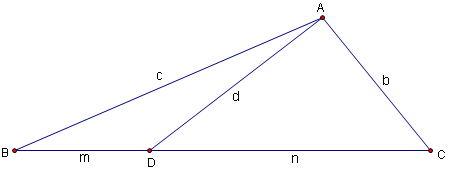Difference between revisions of "Stewart's theorem"
m |
(→Proof 2 (Pythagorean Theorem)) |
||
| Line 23: | Line 23: | ||
== Proof 2 (Pythagorean Theorem) == | == Proof 2 (Pythagorean Theorem) == | ||
| − | Let the [[altitude]] from <math>A</math> to <math>BC</math> meet <math>BC</math> at <math>H</math>. Let <math>AH=h</math>, <math>CH=x</math>, and <math>HD=y</math>. | + | Let the [[altitude]] from <math>A</math> to <math>BC</math> meet <math>BC</math> at <math>H</math>. Let <math>AH=h</math>, <math>CH=x</math>, and <math>HD=y</math>. |
| − | < | + | We can apply the [[Pythagorean Theorem]] on <math>\triangle AHC</math> and <math>\triangle AHD</math> to yield |
| − | + | <math>h^2 = b^2 - x^2 = d^2 - y^2</math> and then solve for b to get <math>b^2 = d^2 + x^2 - y^2</math> | |
| − | + | Doing the same for <math>\triangle AHB</math> and <math>\triangle AHD</math> | |
| − | < | + | <math>h^2 = c^2 - (m + y)^2 = d^2 - y^2</math> then solve for c to get <math>c^2 = d^2 + m^2 + 2my</math> |
| − | + | Now multiple the first expression by m and the second by n | |
| − | < | + | <math>mb^2 = md^2 + m(x^2 - y^2)</math> |
| − | |||
| − | + | <math>nc^2 = nd^2 + m^2n + 2mny</math> | |
| − | + | Next add these two expressions | |
| − | |||
| − | |||
| − | < | + | <math>mb^2 + nc^2 = md^2 + m(x^2 - y^2) + nd^2 + m^2n + 2mny</math>. |
| + | |||
| + | Then simpify as follows (we reapply x + y = n a few times while factoring) | ||
| + | |||
| + | <math>mb^2 + nc^2 = (m + n)d^2 + m(x+y)(x - y) + mn(n + 2y)</math>. | ||
| + | |||
| + | <math>mb^2 + nc^2 = (m + n)d^2 + mn(x - y) + mn(n + 2y)</math>. | ||
| + | |||
| + | <math>mb^2 + nc^2 = (m + n)d^2 + mn(x + y + n)</math>. | ||
| + | |||
| + | <math>mb^2 + nc^2 = (m + n)d^2 + mn(m + n)</math>. | ||
| + | |||
| + | <math>mb^2 + nc^2 = (m + n)(d^2 + mn)</math>. | ||
| + | |||
| + | Rearranging the equation gives Stewart's Theorem: | ||
| + | |||
| + | <math>man+dad = bmb+cnc</math> | ||
~sml1809 | ~sml1809 | ||
Revision as of 20:14, 17 February 2025
Contents
Statement
Given a triangle ![]() with sides of length
with sides of length ![]() and opposite vertices
and opposite vertices ![]() ,
, ![]() ,
, ![]() , respectively, then if cevian
, respectively, then if cevian ![]() is drawn so that
is drawn so that ![]() ,
, ![]() and
and ![]() , we have that
, we have that ![]() . (This is also often written
. (This is also often written ![]() , a phrase which invites mnemonic memorization, i.e. "A man and his dad put a bomb in the sink.") That is Stewart's Theorem. I know, it's easy to memorize.
, a phrase which invites mnemonic memorization, i.e. "A man and his dad put a bomb in the sink.") That is Stewart's Theorem. I know, it's easy to memorize.

Proof 1
Applying the Law of Cosines in triangle ![]() at angle
at angle ![]() and in triangle
and in triangle ![]() at angle
at angle ![]() , we get the equations
, we get the equations
Because angles ![]() and
and ![]() are supplementary,
are supplementary, ![]() . We can therefore solve both equations for the cosine term. Using the trigonometric identity
. We can therefore solve both equations for the cosine term. Using the trigonometric identity ![]() gives us
gives us
Setting the two left-hand sides equal and clearing denominators, we arrive at the equation: ![]() .
However,
.
However,
![]() so
so
![]() and
and
![]() This simplifies our equation to yield
This simplifies our equation to yield ![]() or Stewart's theorem.
or Stewart's theorem.
Proof 2 (Pythagorean Theorem)
Let the altitude from ![]() to
to ![]() meet
meet ![]() at
at ![]() . Let
. Let ![]() ,
, ![]() , and
, and ![]() .
.
We can apply the Pythagorean Theorem on ![]() and
and ![]() to yield
to yield
![]() and then solve for b to get
and then solve for b to get ![]()
Doing the same for ![]() and
and ![]()
![]() then solve for c to get
then solve for c to get ![]()
Now multiple the first expression by m and the second by n
![]()
![]()
Next add these two expressions
![]() .
.
Then simpify as follows (we reapply x + y = n a few times while factoring)
![]() .
.
![]() .
.
![]() .
.
![]() .
.
![]() .
.
Rearranging the equation gives Stewart's Theorem:
![]()
~sml1809
Proof 3 (Barycentrics)
Let the following points have the following coordinates:
![]()
![]()
![]()
![]()
Our displacement vector ![]() has coordinates
has coordinates ![]() . Plugging this into the barycentric distance formula, we obtain
. Plugging this into the barycentric distance formula, we obtain ![]() Multiplying by
Multiplying by ![]() , we get
, we get ![]() . Substituting
. Substituting ![]() with
with ![]() , we find Stewart's Theorem:
, we find Stewart's Theorem: ![]()
~kn07
Nearly Identical Video Proof with an Example by TheBeautyofMath
~IceMatrix









